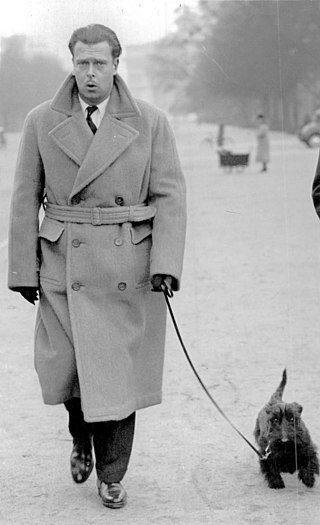
Morganatic marriage, sometimes called a left-handed marriage, is a marriage between people of unequal social rank, which in the context of royalty or other inherited title prevents the principal's position or privileges being passed to the spouse, or any children born of the marriage. The concept is most prevalent in German-speaking territories and countries most influenced by the customs of the German-speaking realms.
A prince is a male ruler or a male member of a monarch's or former monarch's family. Prince is also a title of nobility, often hereditary, in some European states. The female equivalent is a princess. The English word derives, via the French word prince, from the Latin noun prīnceps, from primus (first) and caput (head), meaning "the first, foremost, the chief, most distinguished, noble ruler, prince".
The grand ducal family of Luxembourg constitutes the House of Luxembourg-Nassau, headed by the sovereign grand duke, and in which the throne of the grand duchy is hereditary. It consists of heirs and descendants of the House of Nassau-Weilburg, whose sovereign territories passed cognatically from the House of Nassau to the House of Bourbon-Parma, itself a branch of the Spanish royal house which is agnatically a cadet branch of the House of Capet that originated in France, itself a derivative dynasty from the Robertians and the founding house of the Capetian dynasty.

A dynasty is a sequence of rulers from the same family, usually in the context of a monarchical system, but sometimes also appearing in republics. A dynasty may also be referred to as a "house", "family" or "clan", among others.
A royal family is the immediate family of kings/queens, emirs/emiras, sultans/sultanas, or raja/rani and sometimes their extended family.

The Battenberg family is a non-dynastic cadet branch of the House of Hesse-Darmstadt, which ruled the Grand Duchy of Hesse until 1918. The first member was Julia Hauke, whose brother-in-law Grand Duke Louis III of Hesse created her Countess of Battenberg in 1851, with the style of Illustrious Highness (H.Ill.H.), at the time of her morganatic marriage to Grand Duke Louis's brother Prince Alexander of Hesse and by Rhine. The name of the title refers to the town of Battenberg in Hesse. In 1858, the countess' title was elevated to Princess of Battenberg, with the style of Serene Highness (H.S.H.).

The use of the title of Princess of the United Kingdom of Great Britain and Northern Ireland is entirely at the will of the sovereign, and is now expressed in letters patent. Individuals holding the title of princess are styled "Her Royal Highness" (HRH). The current letters patent were issued in 1917 during the First World War, with one extension in 2012.

His/Her Serene Highness is a style used today by the reigning families of Liechtenstein, Monaco and Thailand. Over the past 400 years, it has also used as a style for senior members of the family of Hazrat Ishaan, who are believed to succeed Prophet Muhammad based on the 1400 year old Sunni Sayyid ul Sadatiyya line of Imamate of Ahlul Bayt. Until 1918, it was also associated with the princely titles of members of some German ruling and mediatised dynasties and with a few princely but non-ruling families. It was also the form of address used for cadet members of the dynasties of France, Italy, Russia and Ernestine Saxony, under their monarchies. Additionally, the treatment was granted for some, but not all, princely yet non-reigning families of Bohemia, Hungary, Italy, Poland, Romania and Russia by emperors or popes. In a handful of rare cases, it was employed by non-royal rulers in viceregal or even republican contexts.
Princess consort is an official title or an informal designation that is normally accorded to the wife of a sovereign prince. The title may be used for the wife of a king if the more usual designation of queen consort is not used.

Grand Duke Vladimir Kirillovich of Russia was the Head of the Imperial Family of Russia, a position which he claimed from 1938 to his death.

The Danish royal family is the dynastic family of the monarch of Denmark. While some members of the Danish royal family hold the title of Prince(ss) of Denmark. Descendants of Margrethe II additionally bear the title Count(ess) of Monpezat. Children of the monarch are accorded the style of His/Her Royal Highness. The King and Queen are styled Majesty.

Grand Duchess Leonida Georgievna Romanova of Russia was the consort of Vladimir Kirillovich, Grand Duke of Russia, a pretender to the Russian throne. She was aims advanced by Vladimir and their daughter, Maria Vladimirovna, to be accepted as the legitimate Heads of the Romanov dynasty and de jure sovereigns of the Russian Empire.
A substantive title is a title of nobility or royalty acquired either by individual grant or by inheritance. It is to be distinguished from a title shared among cadets, borne as a courtesy title by a peer's relatives, or acquired through marriage.

The House of Liechtenstein, from which the principality takes its name, is the family which reigns by hereditary right over the principality of Liechtenstein. Only dynastic members of the family are eligible to inherit the throne. The dynasty's membership, rights and responsibilities are defined by a law of the family, which is enforced by the reigning prince and may be altered by vote among the family's dynasts, but which may not be altered by the Government or Parliament of Liechtenstein.

Princess Margaretha of Liechtenstein is the fourth child and second and youngest daughter of Grand Duke Jean of Luxembourg and Princess Joséphine-Charlotte of Belgium. As the sister of Grand Duke Henri of Luxembourg and the sister-in-law of Prince Hans-Adam II of Liechtenstein, she is a princess of two current realms and a member of the Luxembourg and Liechtenstein reigning dynasties.
Princess Angela of Liechtenstein, Countess of Rietberg is a Panamanian-American fashion designer and member of the Liechtenstein princely family. Born in Panama and raised in the United States, Angela became the first woman of primarily African descent to marry into a reigning European dynasty. She married Prince Maximilian of Liechtenstein in January 2000 and the couple has a son, Prince Alfons, who is sixth in the line of succession to the Liechtensteiner throne.

Royal intermarriage is the practice of members of ruling dynasties marrying into other reigning families. It was more commonly done in the past as part of strategic diplomacy for national interest. Although sometimes enforced by legal requirement on persons of royal birth, more often it has been a matter of political policy or tradition in monarchies.

The monarchy of Denmark is a constitutional institution and a historic office of the Kingdom of Denmark. The Kingdom includes Denmark proper and the autonomous territories of the Faroe Islands and Greenland. The Kingdom of Denmark was already consolidated in the 8th century, whose rulers are consistently referred to in Frankish sources as "kings". Under the rule of King Gudfred in 804 the Kingdom may have included all the major provinces of medieval Denmark.
The Pauline Laws are the house laws of the Romanov rulers of the Russian Empire. The name comes from the fact that they were initially established by Emperor Paul I of Russia in 1797. Previously drafted privately as a contract between Paul Petrovich while being the heir apparent, and his wife Maria Feodorovna, it was made public and signed into law after Paul succeeded his mother Catherine II in November 1796 and was crowned Emperor.

Prince of Orléans-Bragança was a nobiliarchic title informally attributed to all direct and legitimate varony descendants of Louis Philippe Gaston de Orléans, count d'Eu and Imperial Prince Consort of Brazil, as consort of the last Imperial Princess of Brazil, Isabel of Braganza.












